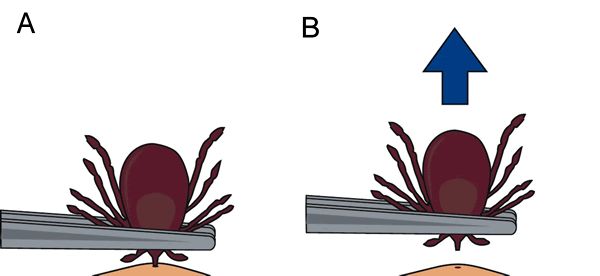Lyme disease
Lyme disease is an infection caused by bacteria that are transmitted to humans through the bite of an infected blacklegged deer tick. Ticks become infected by feeding on infected mice, other rodents, small mammals and birds. White-tailed deer can transport the attached ticks to new areas.
In Canada, Lyme disease is on the increase. It is most common in parts of British Columbia, Manitoba, Ontario, Quebec, New Brunswick and Nova Scotia. But, it may be spreading to other provinces.
Lyme disease is most common in children aged 5 to 9 years and adults aged 55 to 59 years.
What does a deer tick look like?
A tick’s size and colour depends on the stage of development and how long the tick has been feeding. The picture shows deer ticks at different stages.
How can I protect my child from deer ticks?
Ticks cannot jump or fly. They climb tall grasses or shrubs and wait for potential hosts to brush against them.
If you live, hike or camp in rural or wooded areas where you may be exposed to ticks, especially from late spring to early fall, you should take precautions. Here is what you can do to help prevent contact with infected ticks:
- In wooded areas and parks, stay on paths to avoid areas where ticks are most common.
- Ensure you and your children are dressed in long, loose-fitting clothes that cover the arms and legs, a hat and closed shoes (not sandals). Tucking shirts into pants and pants into socks are extra precautions.
- Use insect repellents containing DEET or icaridin as directed on the label. Reapply as suggested.
- Practice daily “full body” checks for ticks, and remove any attached ticks.
- Shower or bathe within a few hours of being outdoors.
- Keep gardens tidy and landscaped if you live near a wooded area.
Currently, there is no vaccine to prevent Lyme disease in humans.
How do I remove a tick from my child?
If you find a tick attached to your child, remove it as soon as possible. Ticks can stay attached and feed for five or more days. Removing a tick within 24 to 36 hours of it starting to feed is likely to prevent Lyme disease.
- Use fine-tipped tweezers to grasp the tick’s mouth-part area (not the body) close to the skin surface (Figure A).
- Pull upward with steady, even pressure (Figure B).
- Don’t twist or jerk the tick; this can cause the mouth-parts to break off and stay in the skin. If this happens, remove the mouth-parts with tweezers. If you can’t, leave it alone and let the skin heal.
- When possible, disinfect the bite area after removal (with an antiseptic like rubbing alcohol).


Figure A and B - Reproduced with permission from the United States Centers for Disease Control and Prevention (Atlanta, USA).
What are the signs and symptoms of Lyme disease?
Lyme disease has three stages. Not everyone experiences all symptoms. Children treated with antibiotics in the early stage almost never develop late stages of the disease.
Early stage:
- In about 70 per cent of children with early Lyme disease: A circular or oval expanding pink or red rash (which often looks like a bull’s eye) called erythema migrans at the site of a recent tick bite. The rash can be more than 5 cm (2 inches) across, and almost always develops from 3 to 30 days after a tick bite. Unlike skin infections, it is usually painless.
- Fever, general discomfort, headache, mild neck stiffness, muscle and/or joint pain may be present with or without the rash.
- Blood tests for Lyme disease should not be done in the early stages, because they are usually negative. If someone has been in area with known Lyme disease and develops a rash that is thought to possibly be erythema migrans, they should be treated with antibiotics that work for Lyme disease. A person who has no rash but has other possible signs or symptoms of Lyme disease after a tick bite should see a doctor.
Second stage, when the bacteria spread in the body:
- Multiple erythema migrans rashes may appear several weeks after the tick bite.
- Facial paralysis (Bell’s palsy) may appear as weakness in the muscles of one side of the face (sometimes both sides), often noticed as an uneven smile.
- Meningitis may appear with fever, headache, stiff or sore neck.
- Heart disease is rare, especially in children.
Late stage:
- Arthritis (swelling, warmth) affecting knees or larger joints weeks to months after a tick bite. Usually only one joint is affected. Swelling may develop over days or may come and go over weeks to months.
- Neurological disease is uncommon in children.
Post-Lyme disease persistent symptoms:
- Som people can still have fatigue or other symptoms even after treatment.
Blood tests for Lyme disease
If your doctor recommends a blood test for Lyme disease, it should be done through a licenced public health laboratory in Canada. Tests offered by private, non-licenced laboratories are not reliable
When should I call a doctor?
If you find an engorged tick on your child or if it has been attached for more than 36 hours, talk to your doctor or local health authorities. In areas with a lot of Lyme disease, they may recommend a single dose of an antibiotic to prevent Lyme disease from starting.
Call the doctor right away if your child develops signs or symptoms of Lyme disease or feels unwell after a tick bite. All stages of Lyme disease can be treated with antibiotics. Early diagnosis and treatment with antibiotics can cure Lyme disease.
Additional resources
Reviewed by the following CPS committees
- Infectious Diseases and Immunization Committee
Last updated: September 2020

